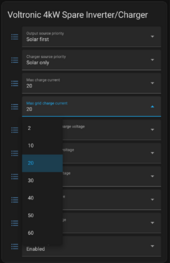One way around that would be ignoring any mains feedthrough altogether, just run from the inverter fulltime, with a high capacity charger fed from the mains and set so that doesn't do much normally (ie the solar provides the bulk of the charging, with the mains charger only used when the battery bank is well down... ie max charge voltage is set lower than normal, so it kicks in on low bank voltage, but stops again when the bank is still well from being fully charged
This is a common tactic used in many offgrid systems with an automatic generator start backup- you don't 'want' the generator to run for a long period ($$$ for fuel) to fully recharge the battery bank, just provide the power enough to keep things running until the sun comes up again... then let the solar do the rest for free...
Best of all, with the auto start genpacks for a fully offgrid system- its all totally automatic- the genpack starts up at the 'critical' level, and only puts in enough to 'top it up a bit, then shuts down again- should the batteries drop enough again, it repeats until the solar does the rest of the bulk charge...
So effectively the entire system runs off the battery bank permanently, until the batteries are depleted to whatever level you set as your 'critical' level say 20% left, then the genny kicks in and runs for a short while (boosting up the charge partially say to 40%) and leaving the rest for the solar to do for free- by careful voltage selection, it is easy to do all this simply by selecting the appropriate volts low and max charge volts limits...
It does rely on the system being capable of handling the full loads (or multiple smaller systems each doing part of the loads) and in this case the mains grid takes the place of the 'backup' genny, with the offgrid inverter taking the place of the mains...- basically a standard system but running in reversed roles...
This is once again, something that is possible to do with already existing certified gear, making it much easier to do than trying to get past an inspection with non certified gear... (and of course once the electrical inspector has signed off, then you can do whatever you please on the 'offgrid' side legally lol- want more panels or more battery storage or a bigger inverter (up to the limits of the input)- just fit it and run...)
The other advantage is that in a pinch, you can just 'flip a switch' and it becomes a bog standard mains wired house- with increased bills of course- but should you have an equipment failure for any reason- you aren't left stranded or relying on a generator..., you still got that huge 'Gigawatts generator' running in from the street ;-)
This is a common tactic used in many offgrid systems with an automatic generator start backup- you don't 'want' the generator to run for a long period ($$$ for fuel) to fully recharge the battery bank, just provide the power enough to keep things running until the sun comes up again... then let the solar do the rest for free...
Best of all, with the auto start genpacks for a fully offgrid system- its all totally automatic- the genpack starts up at the 'critical' level, and only puts in enough to 'top it up a bit, then shuts down again- should the batteries drop enough again, it repeats until the solar does the rest of the bulk charge...
So effectively the entire system runs off the battery bank permanently, until the batteries are depleted to whatever level you set as your 'critical' level say 20% left, then the genny kicks in and runs for a short while (boosting up the charge partially say to 40%) and leaving the rest for the solar to do for free- by careful voltage selection, it is easy to do all this simply by selecting the appropriate volts low and max charge volts limits...
It does rely on the system being capable of handling the full loads (or multiple smaller systems each doing part of the loads) and in this case the mains grid takes the place of the 'backup' genny, with the offgrid inverter taking the place of the mains...- basically a standard system but running in reversed roles...
This is once again, something that is possible to do with already existing certified gear, making it much easier to do than trying to get past an inspection with non certified gear... (and of course once the electrical inspector has signed off, then you can do whatever you please on the 'offgrid' side legally lol- want more panels or more battery storage or a bigger inverter (up to the limits of the input)- just fit it and run...)
The other advantage is that in a pinch, you can just 'flip a switch' and it becomes a bog standard mains wired house- with increased bills of course- but should you have an equipment failure for any reason- you aren't left stranded or relying on a generator..., you still got that huge 'Gigawatts generator' running in from the street ;-)




